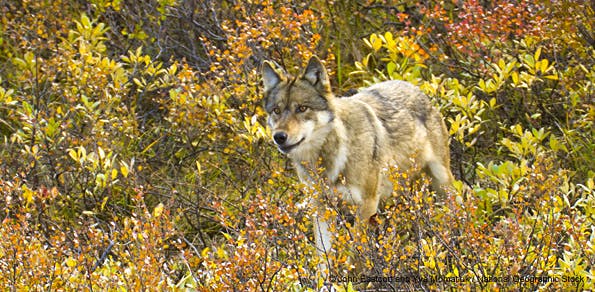
Wolves, like this on in the Cascade Mountains, are receiving the ire of the Yakima County Farm Bureau even though only one livestock loss has been attributed to wolves in Washington in more than five years.
Tempers flare in Pacific Northwest – Though there are fewer than 30 wolves in Washington, and the state’s wolf management plan has only recently been approved, wolf opponents are already pushing for more aggressive control actions. Legislators are proposing a significant decrease in the fine for illegally killing wolves from $4,000 to $1,000 and relisting wolves as a “game” animal instead of endangered. The Yakima County Farm Bureau is opposing the state’s wolf plan outright. Some of their members want all wolves to be eliminated, even though there has only been one confirmed livestock loss to wolves since they returned to Washington more than five years ago.
At least some landowners are taking a more measured approach. Dan Studley, quoted in the Yakima Herald, says he’s not too concerned about wolves:
“(The wolves) came on their own. They weren’t planted,” Studley said. “I look at them like the bear and the cougar and the elk and everything else around us. They’re just wildlife. I don’t oppose them at all. If they became a problem and (state officials) had to trap some and movement, then they’ll do that.
“I just don’t see that they’re going to impact our lives that much.”
As the story points out, Defenders has already chipped in $15,000 in start-up funds to help Washington get a compensation program off the ground. We are also organizing another series of workshops to help local, state, federal and tribal wildlife managers enhance their skills in field investigations and nonlethal deterrents.
Montana county considers wolf bounty – This week, anti-wolf zealots in Jefferson County, Montana are pushing to reinstate a wolf bounty program that would pay people for killing wolves. Only three cattle were lost to wolves in Jefferson County in 2011 according to state compensation payment records, but rather than taking steps to learn to live with wolves, county commissioners are considering a bounty to encourage all wolves to be killed. But not all residents of Jefferson County are on board with the proposed bounty. One hunter, quoted in the local paper, said that the state should be given a chance to manage wolves responsibly before counties take more aggressive action. Another person suggested that cougars and coyotes are likely taking more elk calves and fawns than wolves are, and another said bounties often amount to legalized fraud. Read more in the Helena Independent Record.
Wood River overseas – This summer we were lucky enough to have Pete Haswell, a young biologist from the UK Wolf Conservation Trust, volunteering on the Wood River Wolf Project. He spent his days and nights with our field team tracking wolves and sheep through the central Idaho wilderness, and when he returned, he had some great stories to tell. One night he came within 60 feet of a wolf in the Phantom Hill pack and exchanged late night howls with other packs as well. More importantly, he got to learn first-hand about the nonlethal tools we use to deter wolf attacks, which he hopes to utilize in his work in Eastern Europe. Pete also created an interactive map to keep track of known wolf locations in relation to grazing bands of sheep. Read more about Pete’s adventures in Idaho in the latest issue of Wolf Print, the quarterly magazine of UKWCT (see pg. 14). Pete also wrote a blog post for Defenders during Wolf Awareness Week.
Video of OR7 in his Oregon days – While OR7 remains in northern California in the shadows of Mt. Lassen, his legend continues to spread. This week a video surfaced of the lone male wolf from his Oregon days. The goal of the group named “Oregon Wolf Education” that sponsored the video is “to educate people on how the recent invasion of the Canadian gray wolf is affecting our lives.” But the video also tells a different story of a lone wolf that repeatedly moved through cattle pastures without causing trouble, due at least in part to the effective use of a range rider. Decide for yourself whether the short video portrays OR7 as a serious threat or just another wild animal sharing the landscape:
And in case you missed it, OR7 has also made news in the New York Times and TIME magazine!
What does the data show? – Understanding wolf behavior and their interactions with both wild ungulates and livestock isn’t easy. Wolves share the landscape with other animals that target the same prey, so it takes some careful analysis to determine the impact of any one species on another. That’s why Montana Fish, Wildlife and Parks is leading an in-depth study of predator-prey interactions in the Bitterroot Valley, where elk herds have declined in recent years. There are two years remaining in the study, but so far state biologists are learning that cougars in the area may be having a bigger impact on elk populations than wolves (last year, cougars killed 13 tagged elk calves and wolves killed three). The results of the study should yield important information about the relative impact of wolves on elk. Read more in this feature story from the Missoula Independent.






Follow Defenders of Wildlife
facebook twitter instagram youtube tiktok threads